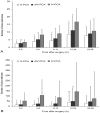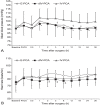Effects of dexmedetomidine in combination with fentanyl-based intravenous patient-controlled analgesia on pain attenuation after open gastrectomy in comparison with conventional thoracic epidural and fentanyl-based intravenous patient-controlled analgesia
- PMID: 28924366
- PMCID: PMC5599918
- DOI: 10.7150/ijms.20347
Effects of dexmedetomidine in combination with fentanyl-based intravenous patient-controlled analgesia on pain attenuation after open gastrectomy in comparison with conventional thoracic epidural and fentanyl-based intravenous patient-controlled analgesia
Abstract
Background: This study was investigated the effects of dexmedetomidine in combination with fentanyl-based intravenous patient-controlled analgesia (IV-PCA) on pain attenuation in patients undergoing open gastrectomy in comparison with conventional thoracic epidural patient-controlled analgesia (E-PCA) and IV-PCA. Methods: One hundred seventy-one patients who planned open gastrectomy were randomly distributed into one of the 3 groups: conventional thoracic E-PCA (E-PCA group, n = 57), dexmedetomidine in combination with fentanyl-based IV-PCA (dIV-PCA group, n = 57), or fentanyl-based IV-PCA only (IV-PCA group, n = 57). The primary outcome was the postoperative pain intensity (numerical rating scale) at 3 hours after surgery, and the secondary outcomes were the number of bolus deliveries and bolus attempts, and the number of patients who required additional rescue analgesics. Mean blood pressure, heart rate, and adverse effects were evaluated as well. Results: One hundred fifty-three patients were finally completed the study. The postoperative pain intensity was significantly lower in the dIV-PCA and E-PCA groups than in the IV-PCA group, but comparable between the dIV-PCA group and the E-PCA group. Patients in the dIV-PCA and E-PCA groups needed significantly fewer additional analgesic rescues between 6 and 24 hours after surgery, and had a significantly lower number of bolus attempts and bolus deliveries during the first 24 hours after surgery than those in the IV-PCA group. Conclusions: Dexmedetomidine in combination with fentanyl-based IV-PCA significantly improved postoperative analgesia in patients undergoing open gastrectomy without hemodynamic instability, which was comparable to thoracic E-PCA. Furthermore, this approach could be clinically more meaningful owing to its noninvasive nature.
Keywords: dexmedetomidine; epidural; fentanyl; intravenous; patient-controlled analgesia; postoperative pain..
Conflict of interest statement
Competing Interests: The authors have declared that no competing interest exists.
Figures




Similar articles
-
Comparison of the effects of patient-controlled epidural and intravenous analgesia on postoperative bowel function after laparoscopic gastrectomy: a prospective randomized study.Surg Endosc. 2017 Nov;31(11):4688-4696. doi: 10.1007/s00464-017-5537-6. Epub 2017 Apr 7. Surg Endosc. 2017. PMID: 28389801 Clinical Trial.
-
Comparison of Dexmedetomidine and Fentanyl as an Adjuvant to Ropivacaine for Postoperative Epidural Analgesia in Pediatric Orthopedic Surgery.Yonsei Med J. 2017 May;58(3):650-657. doi: 10.3349/ymj.2017.58.3.650. Yonsei Med J. 2017. PMID: 28332374 Free PMC article. Clinical Trial.
-
Dexmedetomidine added to an opioid-based analgesic regimen for the prevention of postoperative nausea and vomiting in highly susceptible patients: A randomised controlled trial.Eur J Anaesthesiol. 2016 Feb;33(2):75-83. doi: 10.1097/EJA.0000000000000327. Eur J Anaesthesiol. 2016. PMID: 26258655 Clinical Trial.
-
The fentanyl HCl patient-controlled transdermal system (PCTS): an alternative to intravenous patient-controlled analgesia in the postoperative setting.Clin Pharmacokinet. 2005;44 Suppl 1:1-6. doi: 10.2165/00003088-200544001-00002. Clin Pharmacokinet. 2005. PMID: 16156110 Review.
-
Patient-controlled modalities for acute postoperative pain management.J Perianesth Nurs. 2005 Aug;20(4):255-67. doi: 10.1016/j.jopan.2005.05.005. J Perianesth Nurs. 2005. PMID: 16102706 Review.
Cited by
-
Effectiveness of different doses of dexmedetomidine on intraoperative haemodynamic profiles and postoperative pain in patients undergoing abdominal surgery at Dilla University Referral Hospital, Ethiopia, 2024: a double-blind randomized controlled trial.Ann Med Surg (Lond). 2024 Apr 29;86(8):4495-4504. doi: 10.1097/MS9.0000000000002094. eCollection 2024 Aug. Ann Med Surg (Lond). 2024. PMID: 39118723 Free PMC article.
-
Effects of Remimazolam vs. Sevoflurane Anesthesia on Intraoperative Hemodynamics in Patients with Gastric Cancer Undergoing Robotic Gastrectomy: A Propensity Score-Matched Analysis.J Clin Med. 2022 May 8;11(9):2643. doi: 10.3390/jcm11092643. J Clin Med. 2022. PMID: 35566769 Free PMC article.
-
Dexmedetomidine and sufentanil combination versus sufentanil alone for postoperative intravenous patient-controlled analgesia: a systematic review and meta-analysis of randomized controlled trials.BMC Anesthesiol. 2019 May 18;19(1):81. doi: 10.1186/s12871-019-0756-0. BMC Anesthesiol. 2019. PMID: 31103031 Free PMC article.
-
Perioperative Dexmedetomidine Fails to Improve Postoperative Analgesic Consumption and Postoperative Recovery in Patients Undergoing Lateral Thoracotomy for Thoracic Esophageal Cancer: A Randomized, Double-Blind, Placebo-Controlled Trial.Pain Res Manag. 2020 May 6;2020:4145893. doi: 10.1155/2020/4145893. eCollection 2020. Pain Res Manag. 2020. PMID: 32454920 Free PMC article. Clinical Trial.
-
Efficacy and safety evaluation of dexmedetomidine for postoperative patient controlled intravenous analgesia: A systematic review and meta-analysis.Front Pharmacol. 2022 Dec 12;13:1028704. doi: 10.3389/fphar.2022.1028704. eCollection 2022. Front Pharmacol. 2022. PMID: 36578546 Free PMC article.
References
-
- Wu Y, Liu F, Tang H, Wang Q, Chen L, Wu H, Zhang X, Miao J, Zhu M, Hu C. et al. The analgesic efficacy of subcostal transversus abdominis plane block compared with thoracic epidural analgesia and intravenous opioid analgesia after radical gastrectomy. Anesthesia and analgesia. 2013;117(2):507–513. - PubMed
-
- Zhu Z, Wang C, Xu C, Cai Q. Influence of patient-controlled epidural analgesia versus patient-controlled intravenous analgesia on postoperative pain control and recovery after gastrectomy for gastric cancer: a prospective randomized trial. Gastric cancer: official journal of the International Gastric Cancer Association and the Japanese Gastric Cancer Association. 2013;16(2):193–200. - PubMed
-
- Manion SC, Brennan TJ. Thoracic epidural analgesia and acute pain management. Anesthesiology. 2011;115(1):181–188. - PubMed
Publication types
MeSH terms
Substances
LinkOut - more resources
Full Text Sources
Other Literature Sources
Medical

